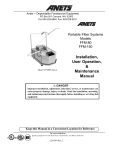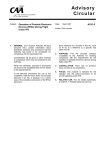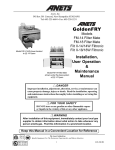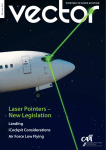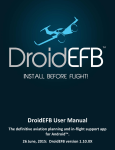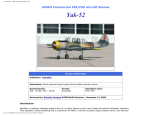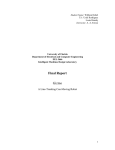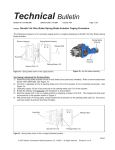Download Castleberry's Wheelchair 300-14EL User's Manual
Transcript
CASTLEBERRY Instruments & Avionics MODEL 300-14EL ATTITUDE GYRO OPERATOR GUIDE __________________________________________________________________________________________ Document: 0052-1001-0001 Page 1 of 4 Revision B CASTLEBERRY Instruments & Avionics Model 300-14EL Operator Guide General Information This attitude indicator is a precision gyroscopic instrument that provides the pilot with a visual reference of the aircraft pitch and roll attitude with respect to earth. To achieve this desired attitude indication, the gyro establishes and maintains a stabilized datum reference perpendicular to the earth. This rigidity in space is developed by a gimbal mounted high speed self erecting rotor that generates enough angular momentum to overcome small frictional forces. This gyro is electrically operated to provide power for the rotor. The spinning mass rotor provides both the gyroscopic effect and turns impellers to create air flow to provide the leveling torque to keep gyro perpendicular to the earth. This gyro is calibrated for standard rate turns. Turns that are faster will create larger errors in pitch and roll such that when turn is completed it will require more time for gyro to return to a true vertical position. A Gyro Flag is controlled by a monitor circuit that indicates the integrity of gyro. Emergency Procedures In the event that the Gyro Flag comes into view, the accuracy of the gyro is in question until the flag goes back out of view and the attitude indication is compared with another attitude reference. This situation should also prompt the verification of the quality of the gyro power source. Pre-flight Procedures During pre-flight procedures the attitude gyro must be provided adequate electrical power with vibration to simulate normal environmental conditions. This is usually achieved by having engines running. After observing the Gyro Flag go out of view, initial erection is accomplished by pulling the “Pull For Quick Erect” knob to cage the gyro while the aircraft is in a level or near level position. After caging the gyro will quickly settle to true level. In a tail-dragger aircraft the caging operation should not be done until after take-off in level flight. This knob is spring loaded to return caging mechanism to its normal position. In-flight Procedures CAUTION: Caging the gyro by pulling the “Pull For Fast Erect” knob while in flight when the aircraft is not level will cause the gyro to be incorrect. The Parallax indicator may be adjusted anytime to remove parallax from pilot’s view. __________________________________________________________________________________________ Document: 0052-1001-0001 Page 2 of 4 Revision B CASTLEBERRY Instruments & Avionics Figure 1 5. Roll Dial 4. Roll Indice 6. Gyro Flag 3. Pitch Dial 7. Inclinometer 2. Parallax Indicator 1. Parallax Adjust 8. Caging Knob Observe Figure 1 for description of features as follows: 1. Parallax Adjustment Knob is used to set the Parallax Indicator (item 2) reference on the actual gyro horizon after settling as viewed by the pilot. Aircraft engines should be on during this process to apply nominal operating voltage to gyro and to generate the required vibration to overcome static friction to simulate a real operating environment. Normal operation would be to turn gyro on and allow for gyro to spin up till flag (item 6) hides out of view, then perform a caging operation (explained for item 8) and then allow gyro a few minutes to settle to level. The gyro is settled when both pitch and roll indications remain constant. The Parallax may be set on ground when the aircraft is level as it would be in a trimmed straight and level flight or set in air during straight and level trimmed flight with wingtips and pitch reference on the earth’s horizon. At this time the Parallax Adjustment knob should be set so that at the pilots viewing angle of the Parallax Indicator rests centered on the horizon line of the Pitch Dial (item 3). Once the parallax is set it is generally not changed again unless the pilot’s seat has moved or a different height pilot requires a different viewing angle. 2. This is the Parallax Indicator. Purpose and operation is described in paragraph 1 which is the adjustment that sets the position of this item. __________________________________________________________________________________________ Document: 0052-1001-0001 Page 3 of 4 Revision B CASTLEBERRY Instruments & Avionics 3. Item 3 is the Pitch Dial. The gyro pitch attitude angle is determined by reading the Pitch Dial position against the Parallax Indicator (previously set in item 1). Note: The horizon line on the Pitch Dial may or may not be exactly aligned with the zero indices of the Roll Dial (item 5) at true level. This can be due to the ± 1½ degree tolerance that is typical for attitude gyros. 4. This is the Roll Indice. The roll attitude angle is read by the position of the Roll Dial (item 5) against this indice. 5. Roll Dial. See Item 4. 6. The Gyro Flag is a monitor to determine integrity of gyro. It is controlled by internal circuitry that will cause the Flag to come into view if input power or gyro RPM becomes too low. Since it is affected by gyro RPM, the Flag does not go out of view immediately when power is applied. Typically it takes 1 to 3 minutes for the Flag to go out of view and up to 5 minutes if operating with low voltage. 7. This is the inclinometer. It is a required device when this gyro is installed as a replacement for the turn indicator gyro per FAA advisory circular AC91-75. 8. This knob is used for quick erect. Operation of the “Pull For Quick Erect” knob is done by a steady pulling outward on the knob with a couple pounds of force until the gyro presentation has stopped moving and in a level indication of both pitch and roll attitude and then gently releasing the knob to return to its spring loaded position. This operation is called caging. It is normal for the gyro inertia to create or not to create a tumbling effect during this operation depending upon its position at the time the knob was pulled. Even though the gyro looks level after caging, it is really only level at this time if the aircraft was perfectly level when the caging was done. Immediately after caging, the gyro will begin to settle towards true level. By being somewhat close to level when caging the gyro, it should settle to true level in a short period of time producing the “Fast Erect” function. Caution: Caging the gyro by pulling the “Pull For Fast Erect” knob while in flight when the aircraft is not level will cause the gyro to be incorrect. __________________________________________________________________________________________ Document: 0052-1001-0001 Page 4 of 4 Revision B




